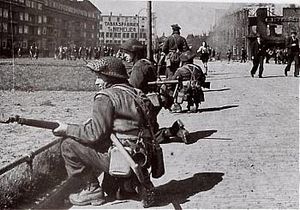Battle of Groningen facts for kids
The Battle of Groningen was an important fight during the last months of World War II in Europe. It happened from April 13 to 16, 1945, in the city of Groningen, Netherlands. About 7,000 German soldiers and some Dutch and Belgian troops fighting for Germany defended the city. They faced the 2nd Canadian Infantry Division, which had around 14,000 soldiers, though not all of them fought at the same time. German air force units with anti-aircraft guns were also in the area. Groningen was also where a German security service, the Sicherheitsdienst, had its main office in the northern Netherlands. The German defenders weren't well organized and had not practiced fighting together.
The Canadian division was made up of nine infantry battalions, a machine gun battalion, and a reconnaissance battalion. They also had three combat engineer companies. These soldiers were experienced in battle, with some newer, partially trained reinforcements. Tanks from the 10th Armoured Regiment (The Fort Garry Horse) and the 9th Armoured Regiment (The British Columbia Dragoons) helped support the Canadian troops.
Quick facts for kids Battle of Groningen |
|||||||
|---|---|---|---|---|---|---|---|
| Part of the North-West Europe campaign in the Western Front of the European theatre of World War II | |||||||
 Canadian troops in action at Groningen. |
|||||||
|
|||||||
| Belligerents | |||||||
| Commanders and leaders | |||||||
| Units involved | |||||||
| Elements of: |
|||||||
| Strength | |||||||
| ~14,000 | ~7,500 | ||||||
| Casualties and losses | |||||||
| 43 dead 166 wounded |
130 dead 5,212 captured |
||||||
Contents
Why the Germans Fought in Groningen
German soldiers fought hard to stop Allied forces from freeing the city from Nazi control. Dutch troops fighting for Germany were worried about what would happen if they surrendered, because of the bad things the SS had done. The Germans also hoped to use Groningen to help their troops retreat safely from Friesland to Germany.
Protecting the Ems River entrance into Germany was also very important. This was because the German navy, the Kriegsmarine, still used Emden as a port for its ships and submarines.
Why the Allies Attacked Groningen
The First Canadian Army was careful about fighting in the western Netherlands. They knew it could cause many deaths, especially among civilians, so late in the war. Instead, they moved northeast to support the British 2nd Army as they entered Germany. This strategy helped them avoid heavy fighting in crowded areas.
Key Moments of the Battle
German forces were mostly set up in the old city center, which was partly protected by an old canal. Some troops were also in the southern suburbs. A group of Germans in the power station gave up after the inner city fell. Canadian troops reached the inner city on April 14.
The western ways into the old town were blocked because bridges over the canal had been destroyed. The Herebrug bridge in the south of the old town was still standing. However, it took a day for the Canadians to defeat German machine gunners in buildings near the bridge.
The Canadians managed to get into the north of the city center, called Nieuwe Stad. This happened after two hours of fighting in the Noorderplantsoen park, which used to be where the city walls were.
The toughest part of the battle was in the central market square, called Grote Markt. There were several German machine guns in the buildings north of the square. Tanks had to destroy these buildings. The Nieuwe Stad was captured, but the Canadians could not reach the Oude Stad from the north because of strong German resistance.
The German commander gave up on April 16. It was clear that fighting any longer would not help. The Canadians used their tanks well, working closely with their infantry. They did not use artillery support to avoid harming the people living in the city.
What Happened After the Battle
About 130 German soldiers, 43 Canadian soldiers, and 100 Dutch civilians died in the battle. Around 270 buildings were damaged or completely destroyed. More than 5,200 German soldiers surrendered, including 95 officers. The remaining 2,000 Germans fled northeast. The 2nd Canadian Division met them again in later battles, like the Battle of Grüppenbühren near Delmenhorst.
Why This Battle Was Important
Groningen was one of the biggest city battles for the Canadian Army during the war. While the Battle of Ortona became famous, Groningen involved five times as many Canadian soldiers fighting directly. This makes it a very significant event in Canadian military history.
More Information
- www.calgaryhighlanders.com
- www.canadiansoldiers.com: "Groningen"

